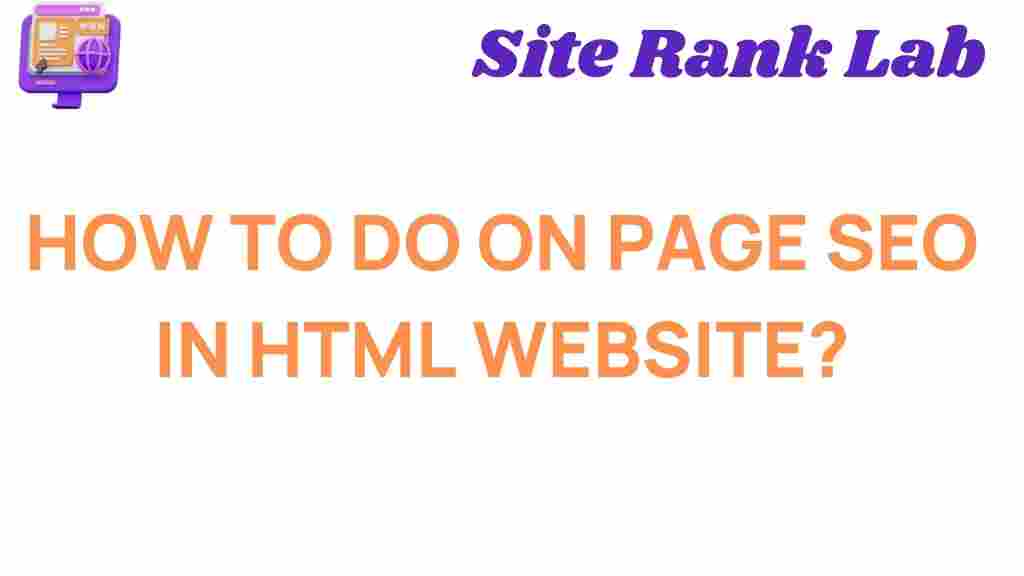Mastering On-Page SEO: Unlocking the Secrets for HTML Websites
In the ever-evolving world of digital marketing, mastering On-Page SEO is crucial for any website, especially for those built on HTML. With the right SEO strategies, you can significantly improve your search engine ranking and enhance user experience. This article will guide you through the essential components of web optimization for HTML websites, focusing on content relevance and best practices to boost your visibility online.
Understanding On-Page SEO
On-Page SEO refers to the optimization of individual web pages to rank higher and earn more relevant traffic in search engines. This includes both the content and the HTML source code of a page. Unlike off-page SEO, which deals with external factors like backlinks, on-page optimization focuses on elements within your control, such as:
- Content quality and relevance
- Title tags and meta descriptions
- Header tags
- Image optimization
- Internal linking
- URL structure
Step-by-Step Process to Optimize HTML Websites
To effectively enhance your HTML website’s On-Page SEO, follow these detailed steps:
1. Conduct Keyword Research
Start by identifying the right keywords for your content. Use tools like Google Keyword Planner, Ahrefs, or SEMrush to find keywords with a good balance of search volume and competition. Focus on:
- Long-tail keywords
- Keywords relevant to your niche
- Keywords with local intent if applicable
2. Optimize Title Tags
Your title tag is one of the most important on-page elements. Ensure it is:
- Under 60 characters
- Includes your primary keyword
- Compelling enough to encourage clicks
3. Craft Compelling Meta Descriptions
Meta descriptions provide a summary of your webpage and should be catchy and informative. Make sure to:
- Keep it under 160 characters
- Include your target keywords
- Encourage users to click through to your site
4. Utilize Header Tags
Header tags (H1, H2, H3, etc.) help organize your content and make it more readable. Use them effectively by:
- Using H1 for the main title (only one per page)
- Using H2 for main sections and H3 for subsections
- Incorporating keywords where relevant
5. Optimize Content for Relevance
Your content should be relevant, informative, and engaging. Here are some tips:
- Use your primary keyword naturally throughout the content.
- Include related keywords and synonyms.
- Aim for a keyword density of 1-1.5%.
- Ensure your content answers the questions your target audience is asking.
6. Improve User Experience
User experience (UX) is a critical factor in On-Page SEO. For HTML websites, focus on:
- Fast loading times: Optimize images and reduce server response times.
- Mobile responsiveness: Ensure your website is mobile-friendly.
- Clear navigation: Make it easy for users to find what they’re looking for.
7. Optimize Images
Images can significantly impact loading times and SEO. To optimize them:
- Use descriptive file names and alt tags that include keywords.
- Compress images to reduce file size without losing quality.
- Use appropriate formats (JPEG for photos, PNG for graphics).
8. Create Internal Links
Internal linking helps establish information hierarchy and guides users through your site. To do this effectively:
- Link to relevant pages within your site.
- Use descriptive anchor text that provides context.
- Ensure a clear structure that enhances navigation.
9. Optimize URL Structure
Your URLs should be clean and descriptive. Follow these best practices:
- Use hyphens to separate words.
- Include target keywords in the URL.
- Avoid using long strings of numbers or irrelevant characters.
10. Monitor and Update Content Regularly
Fresh content is favored by search engines. Regularly review and update your existing content to ensure it remains relevant. Consider:
- Updating statistics and facts.
- Adding new insights or information.
- Improving readability based on user feedback.
Troubleshooting Tips for Common On-Page SEO Issues
Even with the best practices in place, you might encounter issues that can hinder your On-Page SEO. Here are some common problems and solutions:
1. Low Search Rankings
If your rankings are lower than expected, revisit your keyword research and ensure that:
- Your content is truly relevant to the keywords you’re targeting.
- You are not competing against overly saturated keywords.
2. High Bounce Rates
A high bounce rate indicates users are leaving your site quickly. To improve this:
- Enhance content quality and relevance.
- Improve page load speed.
- Ensure your site is user-friendly and easy to navigate.
3. Poor User Engagement
If users are not engaging with your content, consider the following:
- Use visuals to break up text and make content more engaging.
- Incorporate calls-to-action that encourage user interaction.
- Ask questions or include polls to invite responses.
Conclusion
Mastering On-Page SEO for HTML websites involves a multifaceted approach that focuses on optimizing content relevance and enhancing user experience. By implementing the SEO strategies outlined above, you can significantly improve your search engine ranking and achieve better visibility online. Remember, web optimization is an ongoing process—stay updated with the latest trends in digital marketing and continuously refine your strategies.
For further reading on SEO best practices, check out this comprehensive guide. And if you’re looking for more insights on digital marketing strategies, visit this helpful resource.
This article is in the category SEO and created by SiteRankLab Team
